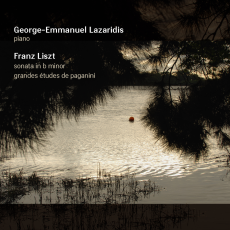George-Emmanuel Lazaridis – Liszt: Sonatas and Etudes
I've always regarded Liszt's B-Minor Sonata as one of music's wonders. Employing cyclic form to combine all the movements of the traditional sonata into one, it demands utmost concentration of the pianist for half an hour. So perfect are its formal outlines and its harmonic scheme that we are always aware of moving towards a destination. When the artist finally takes us there, we breathe a sigh of heartfelt contentment: "You really did it right, Franz!"
Of course, there is also ample scope for virtuosity along the way, and pianist George-Emmanuel Lazaridis gives it to us in double-handfuls in this stunning new offering from Linn Records. In a work that opens and closes softly and has some very intense moments en route, Lazaridis displays complete mastery of the full dynamic range, and Linn's superb multichannel SACD sound allows us to hear it all. This is a pianist to set concert halls afire and cause meltdown on your DVD player.
In terms of rubato, a technique of which Liszt was certainly an advocate, I am less happy with this performance, especially in contrast to the more even-handed approach used by Leonard Pennario in this work in The Early Years (MSR 1188) which I reviewed in last month's New Classik Reviews. Essentially, rubato involves lengthening or condensing increments of time in a musical passage. The word comes from an Italian root meaning "to steal," and like a good thief, the pianist using rubato is obliged to take the time he steals in one place and replace it in another. When you're talking about romantic era music, rubato is always on the table.
Like many young keyboard artists, Lazaridis is inclined to take the dramatic passages very fast and tempestuously, while he has a tendency to really take his time and caress the quieter, more intimate ones. At 33:38, his B-Minor Sonata is on the long side - almost 7 minutes longer than Pennario's, which came as a surprise. Of course, the difference in use of rubato is largely a matter of taste. While I prefer Pennario's approach for the insight it gives me into the music, one cannot deny the tremendous excitement that Lazaridis generates in this work.
The other half of the program consists of six of Liszt's Paganini Etudes, including the two ever-popular "name" Etudes, La Campanella and La Chasse, and the famous 24th Etude that inspired both Brahms and Rachmaninoff to write variations. The dynamic qualities that Lazaridis displayed in the first half of the program are also present here.

